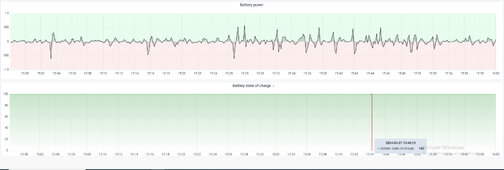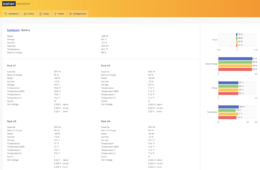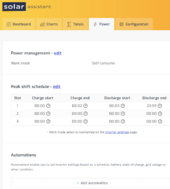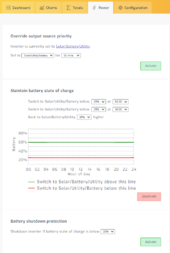You are using an out of date browser. It may not display this or other websites correctly.
You should upgrade or use an alternative browser.
You should upgrade or use an alternative browser.
New 10kw NHX AIO From Watts247
- Thread starter Kornbread
- Start date
Maybe. I can disconnect the battery, but then the inverter will shut off charging completely. I think it will only charge if set to lithium and has comms. So disconnection will stop all charging.Suppose this is where it gets confusing when the battery and inverter are talking. Is the inverter cycling because the battery is telling it to?
Mike C.
Ampster
Renewable Energy Hobbyist
Typically in some systems there is a rebulk setting but that would be overridden by the closed communication from the BMS. I agree with the other poster who said it is possible the the balancing circuit is causing the fluctuations.There seems to be no setting for that in the system.
I would also try a TOU setting of 99% for a time after the battery typically gets fully charged. That worked for me on a SolArk to keep the battery from floating at a high voltage for a few hours until my peak period discharge began at 4PM
Last edited:
Funny you should say that...Set it to lead acid, set voltages, and see what happens?
Today we were running the system grid down on battery to do a burn in test. About 3 hours into the test, the inverter shutdown and the backup panel went dark. Battery was at 88%.
The inverter reported a battery comm error. In lithium mode, if the battery comms has an error, the inverter no longer uses the battery and it shut down. My early apparent success getting the inverter to talk to the battery was falsely encouraging and that protocol isn't 100% reliable.
So I disconnected the battery comm cable, reprogrammed the inverter to lead acid/custom settings, used the EG4 settings in the manual for bulk, float, cutoff, etc. Now the system is running again on battery but this time without battery comm. So far, all is well, but we are only 2 hours into this test so far. I intend to run the battery down to 20% or so overnight to check it out.
If this works, and it seems like it will, then battery comms is a failure point and using old style voltage levels will be more reliable. This will also stop the battery charge/discharge cycling, another indication that battery comms wasn't performing well.
What this also means is that my interest in moving the system to Solar Assistant is higher. With SA, I can separately monitor the inverter, battery #1, and battery #2. I can then automate any actions based on battery SoC in SA if I want to.
The Solarman app that comes with the unit is mediocre at best. I am sure SA will be far superior to monitor and control the unit.
The supplied CTs with the unit have a cable length of about 6 ft or so. For my install that worked nicely. The CTs sit in the bottom of the main panel where the utility feed comes in. I then run them in a small plastic flex conduit to the trough, then they go to the inverter and plug into the RJ45s there. I have maybe 2 ft spare length. It is important to get the CT arrow direction right, and to get L1 versus L2 right.Can the ct's share a common cat5 cable? They only use two wires. It would be easier to use a splitter at both ends, and run one cat5 the 75' vs two cat5 cables? .

If you were running them further, then I would take one network cable and use two punch down RJ45's at each end. Then plug the CTs in the RJ45s at one end, and use a short patch cable at the other to go to the inverter. You would have to learn which pins are active and workout the signal mapping. Make sure to use pins which are twisted together for each CT (pin 1/2, 3/6, 4/5, 7/8).
The CTs supplied fit my feed cables without difficulty (200 amp service).
Mike C.
BarracudaBob
Harvesting free photons from clean fusion
I don't have that page on mine. HummmThis what you are looking for in SA? The power management tab was just populated in the last SA update.
There is also an inverter page w/both inverter's information.
xx
View attachment 217713xx
View attachment 217715
BarracudaBob
Harvesting free photons from clean fusion
Device board: Raspberry Pi 4 Model B Rev 1.4
Software version: 2024-01-23
It must be enabled somewhere else.
Running it under megarevo? Self consume.Device board: Raspberry Pi 4 Model B Rev 1.4
Software version: 2024-01-23
It must be enabled somewhere else.
BarracudaBob
Harvesting free photons from clean fusion
Odd. Before this last update, there was nothing on the power tab. Definitely not what you have. Running it under the configure>Inverter>Megarevo setting?I don't have a use for it so not going to worry about it. Just curious that I didn't have the choice.
View attachment 217721
BarracudaBob
Harvesting free photons from clean fusion
I have EG4 3KOdd. Before this last update, there was nothing on the power tab. Definitely not what you have. Running it under the configure>Inverter>Megarevo setting?
I have it running that way currently. About 120' away. 2 female jacks on the CT end. Two male RJ's on the inverter end. So far its been working well. No battery just offsetting main panel loads when the sun is shining.Set it to lead acid, set voltages, and see what happens?
Can the ct's share a common cat5 cable? They only use two wires. It would be easier to use a splitter at both ends, and run one cat5 the 75' vs two cat5 cables? .
In lead acid mode, still has the charge/discharge spasms:
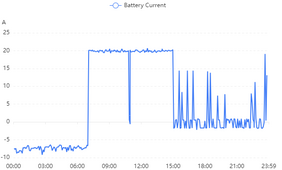
First 7 hours are overnight run on battery for a burn in test, Next 8 hours are charge from grid (with one brief interruption), last 9 hours are battery at 100 % SoC and the unit discharging at about 2 amps followed by spiky charging from 7 to 20 amps. It switches about every few seconds and the chart above is every 5 minutes so it is random what is samples at any given time.
I feel like I need to stop this behavior. I could disable grid charging manually at 100% SoC, but I'm not sure if that will stop the discharge events, or they will simply continue to discharge with no charging going on.
Mike C.

First 7 hours are overnight run on battery for a burn in test, Next 8 hours are charge from grid (with one brief interruption), last 9 hours are battery at 100 % SoC and the unit discharging at about 2 amps followed by spiky charging from 7 to 20 amps. It switches about every few seconds and the chart above is every 5 minutes so it is random what is samples at any given time.
I feel like I need to stop this behavior. I could disable grid charging manually at 100% SoC, but I'm not sure if that will stop the discharge events, or they will simply continue to discharge with no charging going on.
Mike C.
Adam De Lay
Solar Wizard
So with the last 9 hours on the test you have it set to “battery priority”, time of use enabled and SOC set to 100%?In lead acid mode, still has the charge/discharge spasms:
View attachment 217971
First 7 hours are overnight run on battery for a burn in test, Next 8 hours are charge from grid (with one brief interruption), last 9 hours are battery at 100 % SoC and the unit discharging at about 2 amps followed by spiky charging from 7 to 20 amps. It switches about every few seconds and the chart above is every 5 minutes so it is random what is samples at any given time.
I feel like I need to stop this behavior. I could disable grid charging manually at 100% SoC, but I'm not sure if that will stop the discharge events, or they will simply continue to discharge with no charging going on.
Mike C.
Configuration is:So with the last 9 hours on the test you have it set to “battery priority”, time of use enabled and SOC set to 100%?
Work Mode: Battery Priority
Advanced Mode: Disable
Backup Enable: checked
Sell Enable: unchecked
Grid Export Limit: 0 W
No TOU settings. There is no TOU function desired.
Mike C.
Yesterday, my battery current log:

Shows repeated discharges of about 2 amps with spiky charges of up to 20 amps.
My next tactic is going to be to disable grid charging entirely and see what happens. This should stop the charging, but the question is if it will stop the discharging. If it doesn't, then I have to ask why the inverter sucks on the battery with grid available which it should not do.
Maybe the root cause of this is the inverter sucking on the battery with grid available, which then triggers a recharge, and the cycle repeats.
Mike C.

Shows repeated discharges of about 2 amps with spiky charges of up to 20 amps.
My next tactic is going to be to disable grid charging entirely and see what happens. This should stop the charging, but the question is if it will stop the discharging. If it doesn't, then I have to ask why the inverter sucks on the battery with grid available which it should not do.
Maybe the root cause of this is the inverter sucking on the battery with grid available, which then triggers a recharge, and the cycle repeats.
Mike C.
Is tIn lead acid mode, still has the charge/discharge spasms:
View attachment 217971
First 7 hours are overnight run on battery for a burn in test, Next 8 hours are charge from grid (with one brief interruption), last 9 hours are battery at 100 % SoC and the unit discharging at about 2 amps followed by spiky charging from 7 to 20 amps. It switches about every few seconds and the chart above is every 5 minutes so it is random what is samples at any given time.
I feel like I need to stop this behavior. I could disable grid charging manually at 100% SoC, but I'm not sure if that will stop the discharge events, or they will simply continue to discharge with no charging going on.
Mike C.
my sunny island does this same thing when the battery is full and its on grid. its not something i ever worried aboutYesterday, my battery current log:
View attachment 218193
Shows repeated discharges of about 2 amps with spiky charges of up to 20 amps.
My next tactic is going to be to disable grid charging entirely and see what happens. This should stop the charging, but the question is if it will stop the discharging. If it doesn't, then I have to ask why the inverter sucks on the battery with grid available which it should not do.
Maybe the root cause of this is the inverter sucking on the battery with grid available, which then triggers a recharge, and the cycle repeats.
Mike C.
